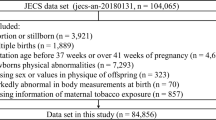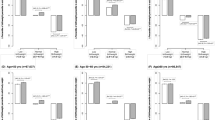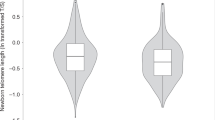Abstract
Background
Previous studies have modeled the association between fetal exposure to tobacco smoke and body mass index (BMI) growth trajectories, but not the timing of catch-up growth. Research on fetal exposure to maternal secondhand smoking is limited.
Objectives
To explore the associations between fetal exposure to maternal active and secondhand smoking with body composition at birth and BMI growth trajectories through age 3 years.
Methods
We followed 630 mother-child pairs enrolled in the Healthy Start cohort through age 3 years. Maternal urinary cotinine was measured at ~ 27 weeks gestation. Neonatal body composition was measured using air displacement plethysmography. Child weight and length/height were abstracted from medical records. Linear regression models examined the association between cotinine categories (no exposure, secondhand smoke, active smoking) with weight, fat mass, fat-free mass, and percent fat mass at birth. A mixed-effects regression model estimated the association between cotinine categories and BMI.
Results
Compared to unexposed offspring, birth weight was significantly lower among offspring born to active smokers (−343-g; 95% CI: −473, −213), but not among offspring of women exposed to secondhand smoke (−47-g; 95% CI: −130, 36). There was no significant difference in the rate of BMI growth over time between offspring of active and secondhand smokers (p = 0.58). Therefore, our final model included a single growth rate parameter for the combined exposure groups of active and secondhand smokers. The rate of BMI growth for the combined exposed group was significantly more rapid (0.27 kg/m2 per year; 95% CI: 0.05, 0.69; p < 0.01) than the unexposed.
Conclusions
Offspring prenatally exposed to maternal active or secondhand smoking experience rapid and similar BMI growth in the first three years of life. Given the long-term consequences of rapid weight gain in early childhood, it is important to encourage pregnant women to quit smoking and limit their exposure to secondhand smoke.
This is a preview of subscription content, access via your institution
Access options
Subscribe to this journal
Receive 12 print issues and online access
$259.00 per year
only $21.58 per issue
Buy this article
- Purchase on Springer Link
- Instant access to full article PDF
Prices may be subject to local taxes which are calculated during checkout


Similar content being viewed by others
References
Butler NR, Goldstein H, Ross EM. Cigarette smoking in pregnancy: its influence on birth weight and perinatal mortality. BMJ. 1972;2:127–30.
von Kries R, Bolte G, Baghi L, Toschke AM. Group GMES. parental smoking and childhood obesity--is maternal smoking in pregnancy the critical exposure? Int J Epidemiol. 2008;37:210–6.
Lindsay CA, Thomas AJ, Catalano PM. The effect of smoking tobacco on neonatal body composition. Am J Obstet Gynecol. 1997;177:1124–8.
Zaren B, Lindmark G, Gebre-Medhin M. Maternal smoking and body composition of the newborn. Acta Paediatr. 1996;85:213–9.
Cliver SP, Goldenberg RL, Cutter GR, Hoffman HJ, Davis RO, Nelson KG. The effect of cigarette smoking on neonatal anthropometric measurements. Obstet Gynecol. 1995;85:625–30.
Harrod CS, Fingerlin TE, Chasan-Taber L, Reynolds RM, Glueck DH, Dabelea D. Exposure to prenatal smoking and early-life body composition: the healthy start study. Obes (Silver Spring). 2015;23:234–41.
Harrod CS, Reynolds RM, Chasan-Taber L, Fingerlin TE, Glueck DH, Brinton JT, et al. Quantity and timing of maternal prenatal smoking on neonatal body composition: the Healthy Start study. J Pediatr. 2014;165:707–12.
de Wit CC, Sas TC, Wit JM, Cutfield WS. Patterns of catch-up growth. J Pediatr. 2013;162:415–20.
Braun JM, Daniels JL, Poole C, Olshan AF, Hornung R, Bernert JT, et al. Prenatal environmental tobacco smoke exposure and early childhood body mass index. Paediatr Perinat Epidemiol. 2010;24:524–34.
Riedel C, Fenske N, Muller MJ, Plachta-Danielzik S, Keil T, Grabenhenrich L, et al. Differences in BMI z-scores between offspring of smoking and nonsmoking mothers: a longitudinal study of German children from birth through 14 years of age. Environ Health Perspect. 2014;122:761–7.
Chen A, Pennell ML, Klebanoff MA, Rogan WJ, Longnecker MP. Maternal smoking during pregnancy in relation to child overweight: follow-up to age 8 years. Int J Epidemiol. 2006;35:121–30.
Haga C, Kondo N, Suzuki K, Sato M, Ando D, Yokomichi H, et al. Developmental trajectories of body mass index among Japanese children and impact of maternal factors during pregnancy. PLoS One. 2012;7:e51896.
Howe LD, Matijasevich A, Tilling K, Brion MJ, Leary SD, Smith GD, et al. Maternal smoking during pregnancy and offspring trajectories of height and adiposity: comparing maternal and paternal associations. Int J Epidemiol. 2012;41:722–32.
Oken E, Huh SY, Taveras EM, Rich-Edwards JW, Gillman MW. Associations of maternal prenatal smoking with child adiposity and blood pressure. Obes Res. 2005;13:2021–8.
Caraballo RS, Giovino GA, Pechacek TF, Mowery PD. Factors associated with discrepancies between self-reports on cigarette smoking and measured serum cotinine levels among persons aged 17 years or older: Third National Health and Nutrition Examination Survey, 1988-1994. Am J Epidemiol. 2001;153:807–14.
Benowitz N, Goniewicz ML, Eisner MD, Lazcano-Ponce E, Zielinska-Danch W, Koszowski B, et al. Urine cotinine underestimates exposure to the tobacco-derived lung carcinogen 4-(methylnitrosamino)-1-(3-pyridyl)-1-butanone in passive compared with active smokers. Cancer Epidemiol Biomark Prev. 2010;19:2795–800.
Zielinska-Danch W, Wardas W, Sobczak A, Szoltysek-Boldys I. Estimation of urinary cotinine cut-off points distinguishing non-smokers, passive and active smokers. Biomarkers. 2007;12:484–96.
Guenther PM, Kirkpatrick SI, Reedy J, Krebs-Smith SM, Buckman DW, Dodd KW, et al. The Healthy Eating Index-2010 is a valid and reliable measure of diet quality according to the 2010 Dietary Guidelines for Americans. J Nutr. 2014;144:399–407.
Shapiro AL, Kaar JL, Crume TL, Starling AP, Siega-Riz AM, Ringham BM et al. Maternal diet quality in pregnancy and neonatal adiposity: The Healthy Start Study. Int J Obes (Lond) 2016;40:1056–62.
Guenther PM, Casavale KO, Reedy J, Kirkpatrick SI, Hiza HA, Kuczynski KJ, et al. Update of the healthy eating index: HEI-2010. J Acad Nutr Diet. 2013;113:569–80.
Moore BF, Sauder KA, Starling AP, Ringham BM, Glueck DH, Dabelea D. Exposure to secondhand smoke, exclusive breastfeeding and infant adiposity at age 5 months in the Healthy Start study. Pediatr Obes. 2017;12:111–9.
American Academy of Pediatrics Committee on Nutrition. Pediatric Nutrition Handbook, 6th edn. American Academy of Pediatrics: Elk Grove Village, IL, 2008.
Demidenko E. Mixed models: theory and applications with R, John Wiley & Sons, Hoboken, New Jersey 2013.
Little RJ, Rubin DB. Statistical analysis with missing data, John Wiley & Sons, Hoboken, New Jersey 2014.
Royston P, Sauerbrei W. Multivariable model-building: a pragmatic approach to regression anaylsis based on fractional polynomials for modelling continuous variables, vol. 777. John Wiley & Sons, Chicheser, England 2008.
Kenward MG, Roger JH. An improved approximation to the precision of fixed effects from restricted maximum likelihood. Comput Stat Data Anal. 2009;53:2583–95.
Pickett KE, Rathouz PJ, Kasza K, Wakschlag LS, Wright R. Self-reported smoking, cotinine levels, and patterns of smoking in pregnancy. Paediatr Perinat Epidemiol. 2005;19:368–76.
Goniewicz ML, Eisner MD, Lazcano-Ponce E, Zielinska-Danch W, Koszowski B, Sobczak A, et al. Comparison of urine cotinine and the tobacco-specific nitrosamine metabolite 4-(methylnitrosamino)-1-(3-pyridyl)-1-butanol (NNAL) and their ratio to discriminate active from passive smoking. Nicotine Tob Res. 2011;13:202–8.
Salmasi G, Grady R, Jones J, McDonald SD. Environmental tobacco smoke exposure and perinatal outcomes: a systematic review and meta-analyses. Acta Obstet Gynecol Scand. 2010;89:423–41.
Windham GC, Eaton A, Hopkins B. Evidence for an association between environmental tobacco smoke exposure and birthweight: a meta-analysis and new data. Paediatr Perinat Epidemiol. 1999;13:35–57.
Ekelund U, Ong K, Linne Y, Neovius M, Brage S, Dunger DB, et al. Upward weight percentile crossing in infancy and early childhood independently predicts fat mass in young adults: the Stockholm Weight Development Study (SWEDES). Am J Clin Nutr. 2006;83:324–30.
Eriksson JG, Forsen T, Tuomilehto J, Winter PD, Osmond C, Barker DJ. Catch-up growth in childhood and death from coronary heart disease: longitudinal study. BMJ. 1999;318:427–31.
Jain V, Singhal A. Catch up growth in low birth weight infants: striking a healthy balance. Rev Endocr Metab Disord. 2012;13:141–7.
Moore BF, Clark ML, Bachand A, Reynolds SJ, Nelson TL, Peel JL. Interactions between diet and exposure to secondhand smoke on the prevalence of childhood obesity: results from NHANES, 2007-2010. Environ Health Perspect. 2016;124:1316–22.
Ong KK. Catch-up growth in small for gestational age babies: good or bad? Curr Opin Endocrinol Diabetes Obes. 2007;14:30–4.
Lehtovirta P, Forss M. The acute effect of smoking on intervillous blood flow of the placenta. Br J Obstet Gynaecol. 1978;85:729–31.
Walsh RA. Effects of maternal smoking on adverse pregnancy outcomes: examination of the criteria of causation. Hum Biol. 1994;66:1059–92.
Somm E, Schwitzgebel VM, Vauthay DM, Camm EJ, Chen CY, Giacobino JP, et al. Prenatal nicotine exposure alters early pancreatic islet and adipose tissue development with consequences on the control of body weight and glucose metabolism later in life. Endocrinology. 2008;149:6289–99.
Bergen HT. Exposure to smoke during development: fetal programming of adult disease. Tob Induc Dis. 2006;3:5–5.
Suter MA, Anders AM, Aagaard KM. Maternal smoking as a model for environmental epigenetic changes affecting birthweight and fetal programming. Mol Hum Reprod. 2013;19:1–6.
Dietz PM, Homa D, England LJ, Burley K, Tong VT, Dube SR, et al. Estimates of nondisclosure of cigarette smoking among pregnant and nonpregnant women of reproductive age in the United States. Am J Epidemiol. 2011;173:355–9.
Kim S. Overview of Cotinine Cutoff Values for Smoking Status Classification. Int J Environ Res Public Health. 2016;13:1236.
Homa DM, Neff LJ, King BA, Caraballo RS, Bunnell RE, Babb SD, et al. Vital signs: disparities in nonsmokers’ exposure to secondhand smoke--United States, 1999-2012. MMWR Morb Mortal Wkly Rep. 2015;64:103–8.
Acknowledgements
We gratefully acknowledge the contributions of Stephen Brindley for performing the laboratory analysis of cotinine.
Funding
This work was supported by the National Institutes of Health (R01DK076648, UG3OD023248, R01ES02293403, R01GM121081, K99ES028711) .
Author information
Authors and Affiliations
Contributions
The authors’ responsibilities were as follows: BFM, APS, SM, JLA, and DD designed the work of this study. CSH, WBA, BMR, and DHG contributed to the data acquisition and interpretation. SM, JLA, and DD supervised. BFM, BMR, and DHG performed the statistical analyses. BFM wrote the manuscript. APS, SM, CSH, WBA, JLA, BMR, DHG, and DD provided critical revisions to the manuscript. All authors read and approved the final manuscript.
Corresponding author
Ethics declarations
Conflict of interest
The authors declare that they have no conflict of interest.
Electronic supplementary material
Rights and permissions
About this article
Cite this article
Moore, B.F., Starling, A.P., Magzamen, S. et al. Fetal exposure to maternal active and secondhand smoking with offspring early-life growth in the Healthy Start study. Int J Obes 43, 652–662 (2019). https://doi.org/10.1038/s41366-018-0238-3
Received:
Revised:
Accepted:
Published:
Issue Date:
DOI: https://doi.org/10.1038/s41366-018-0238-3
This article is cited by
-
Prenatal exposure to tobacco and adverse birth outcomes: effect modification by folate intake during pregnancy
Maternal Health, Neonatology and Perinatology (2022)



